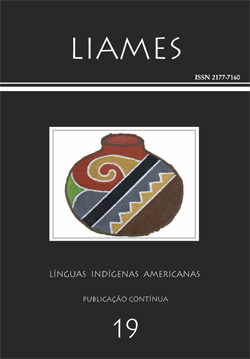Abstract
Eastern Tukanoan languages are known for their developed nominal classification systems. Wa’ikhana (Piratapuyo) is in this sense a typical member of the family, since it has an open system with a big number of classes and with class markers which exercise derivational and agreement functions. Among all the Wa’ikhana inanimate classes, the class ‘round’ stands out for its semantic and morphosyntactic features. It is one of the most (if not the most) extensive class, which includes round objects as well as objects of a less prototypical shape. Its markers in non-plural number have the biggest number of allomorphs, whereas allomorphy of classifiers is not typical for this language. Besides, the class ‘round’ has a distinct plural marker, another feature absent for most classifiers. Comparison between Wa’ikhana and other related languages demonstrates that these peculiarities are shared by many of Eastern Tukanoan languages. Thus, the present paper aims to describe the class ‘round’ in Wa’ikhana and other languages of the family and to show common features as well as features that distinguish Wa’ikhana.
References
Aikhenvald, Alexandra. Y (1994). Classifiers in Tariana. Anthropological Linguistics 36(4): 407-465.
Aikhenvald, Alexandra. Y (2000). Classifiers. A typology of noun categorization devices. New York: Oxford University Press.
Balykova, Kristina (2019). Expressão de propriedades no Guató e no Wa’ikhana (MA dissertation in Linguistics). Rio de Janeiro: UFRJ / CLA.
Barnes, Janet (1990). Classifiers in Tuyuca. In Doris L. Payne (ed.). Amazonian linguistics: studies in Lowland South American languages, pp. 273-292. Austin: University of Texas Press.
Barnes, Janet; Malone, Terrell (2000). El Tuyuca. In M. S. G. de Pérez e M. L. R. de Montes (eds.). Lenguas de Colombia: una visión descriptiva, pp. 437-452. Bogotá: Instituto Caro y Cuervo.
Chacon, Thiago Costa (2007). O sistema de classificação nominal do Tukáno. Revista de Estudos e Pesquisas (FUNAI) 4(2): 147-197.
Chacon, Thiago Costa (2012). The phonology and morphology of Kubeo: the documentation, theory, and description of an Amazonian language (PhD thesis in Linguistics). Mānoa: The University of Hawaiʻi.
Chacon, Thiago Costa (2014). A revised proposal of Proto-Tukanoan consonants and Tukanoan family classification. International Journal of American Linguistics 80(3): 275-322. doi:10.1086/676393
Coutinho-Silva, Thiago (2014). Por dentro dos nomes: a morfologia nominal em Kotiria (Tukano Oriental) (PhD thesis in Linguistics). Rio de Janeiro: Universidade Federal do Rio de Janeiro.
Criswell, Linda; Brandrup, Beverly (2000). Un bosquejo fonológico y gramatical del Siriano. In: M. S. G. de Pérez e M. L. R. de Montes (eds.). Lenguas de Colombia: una visión descriptiva. pp. 395-417. Bogotá: Instituto Caro y Cuervo.
De Pérez, María Stella González (2000). Bases para el estudio de la lengua Pisamira. In: M. S. G. de Pérez and M. L. R. de Montes (eds.). Lenguas de Colombia: una visión descriptiva. pp. 373-393. Bogotá: Instituto Caro y Cuervo.
Epps, Patience (2007). Birth of a noun classification system. The case of Hup. In: W. Leo Wetzels (ed.). Language endangerment and endangered languages, pp. 107-127. Leiden: CNWS Publications.
Eraso, Natalia (2015). Gramática tanimuka, una lengua de la Amazonía colombiana (PhD thesis in Linguistics). Lyon: Université Lumière – Lyon 2.
Gomez-Imbert, Elsa (1982). De la forme et du sense dans la classification nominale en Tatuyo (Langue Tukano Orientale d’Amazonie Colombienne) (PhD thesis in Linguistics). Paris: Université Sorbonne – Paris IV.
Gomez-Imbert, Elsa (2007). Nominal classification in Tukanoan languages. In W. Leo Wetzels (ed.). Language endangerment and endangered languages: linguistic and anthropological studies with special emphasis on the languages and cultures of the Andean-Amazonian Border Area, pp. 401-428. Leiden: Leiden University.
Greenberg, Joseph H. (1972). Numeral classifiers and substantival number: problems in the genesis of a linguistic type. Working papers on language universals 9: 2-39.
Grinevald, Colette (2000). Classifiers. In G. Booij; Ch. Lehmann; J. Mugdan (eds.). Morphology. A handbook on inflection and word formation, pp. 1016-1031. Berlin: Mouton de Gruyter.
Grinevald, Colette; Seifart, Frank (2004). Noun classes in African and Amazonian languages: towards a comparison. Linguistic Typology 8: 243-285.
IBGE – Instituto Brasileiro de Geografia e Estatística (2010). Censo demográfico 2010. Características gerais dos indígenas. Resultados do universo. Rio de Janeiro: IBGE.
Jones, Wendell; Jones, Paula (1991). Barasano syntax: studies in the languages of Colombia 2. Dallas: The Summer Institute of Linguistics e The University of Texas at Arlington.
Kinch, Rodney; Kinch, Pamela (2000). El Yurutí. In M. S. G. de Pérez e M. L. R. de Montes (eds.). Lenguas de Colombia: una visión descriptiva. pp. 469-487. Bogotá: Instituto Caro y Cuervo.
Metzger, Ronald G. (2000). Marĩ yaye mena carapana, yaia yaye mena español macãrĩcã tuti (carapana – español, diccionario de 1000 palabras). Santafé de Bogotá: Editorial Buena Semilla.
Miller, Marion (1999). Desano grammar. Studies in the languages of Colombia 6. The Summer Institute of Linguistics and The University of Texas at Arlington.
Preciado, Iveth Patricia Rodríguez (2018). Aspectos de la morfología nominal y verbal de la lengua Pisamira: una lengua de la familia Tucano Oriental del Noroeste Amazónico (MA dissertation in Linguistics). Brasília: UnB.
Ramirez, Henri (1997). A fala Tukano dos Ye’pâ-Masa. Tomo 1. Gramática. Manaus: Inspetoria Salesiana Missionária da Amazônia, CEDEM.
Rose, Françoise; Lemus Serrano, Magdalena; Eraso, Natalia; Chacon, Thiago (2017). A new look into Arawak-Tukanoan contact: the Yukuna-Tanimuka bidirectional hypothesis. SSILA Annual Meeting, Austin.
Smothermon, Jeffrey R.; Smothermon, Josephine H. (1993). Masa ye, gawa ye rãca ãmara tuti (macuna – español, diccionario de 850 palabras). Santafé de Bogotá: Editorial Alberto Lleras Camargo.
Smothermon, Jeffrey R.; Smothermon, Josephine H.; Frank, Paul S. (1995). Bosquejo del Macuna. Santafé de Bogotá: Associación [sic] Instituto Lingüístico de Verano. Available at: https://www.sil.org/resources/archives/18998
Stenzel, Kristine (2013). A reference grammar of Kotiria (Wanano). Lincoln: University of Nebraska Press.
Stenzel, Kristine; Cezario, Bruna (2019). Wa’ikhana: Wehsepʉ buude wehẽgʉ esamii emo sañuduhkugʉ’ʉ tʉ’osua’ʉ. Revista LinguiStica 15(1): 384-417.
Strom, Clay (1992). Retuarã syntax. studies in the languages of Colombia 3. The Summer Institute of Linguistics and The University of Texas at Arlington.
The LIAMES: Línguas Indígenas Americanas uses the Creative Commons license (CC), thus preserving the integrity of the articles in an open access environment.



